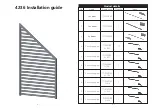
INSTRUCTIONS
SMSLES2X13 INSTALLATION
INSTRUCTIONS
SMSLES2X13 INSTALLATION
RAB Lighting is committed to creating high-quality, affordable, well-designed and energy-efficient LED lighting and controls that make it easy for electricians to install
and end users to save energy. We’d love to hear your comments. Please call the Marketing Department at 888-RAB-1000 or email: [email protected]
RAB Lighting is committed to creating high-quality, affordable, well-designed and energy-efficient LED lighting and controls that make it easy for electricians to install
and end users to save energy. We’d love to hear your comments. Please call the Marketing Department at 888-RAB-1000 or email: [email protected]
Page 13
Page 14
Lights Turn Off Too Quickly
1. Check if sensor is being “tricked” by
reflected light. If lights shine or reflect
into the photocell, (located behind the
lens), the unit will go on briefly and
turn off thinking it is daytime.
Problem:
Lights reflect into photocell
or lights shine directly into photocell.
Solution:
Adjust Photocell Control
slightly clockwise, toward the sun
symbol. This allows the sensor to
function in brighter ambient light
conditions. Alternatively, move the
lights or mask the lens in the direction
of the lights or reflections. If the
problem persists, it may be necessary
to increase the lenth of the sun shield
over the sensor using weatherproof
tabe or some other material.
2. Check if “R” lamps, “A” lamps or self-
ballasted PL lamps are being used in
a non-enclosed lampholder that can
be “seen” by the sensor. If so, switch
to reflector PAR floodlight lamps or
Quartz floods so the sensor is not
affected by stray light. If using PAR
floodlights, consider using lower
wattage, energy saving lamps.
Self ballasted compact fluorescent
lamps may cause the sensor to cycle
on and off.
Lights Turn On For Unknown Reasons
1. Lights may turn on occasionally during
rain, snow and windstorms because
the sensor is detecting changes in
temperature. If this is a constant
problem, mount the sensor in a more
protected area.
2. Tilt the sensor lower - it may be seeing
distant objects moving.
3. You may not be aware that animals
have triggered sensor. Check sensor
aiming to reduce nuisance triggering
or mask the lower part of the lens with
opaque weatherproof tape.
4. The sensor may turn on occasionally
during voltage surges.
5. A possible source of “mysterious”
sensor activations are strong local
radio signals. Check for nearby CB,
Ham, VHF radio transmitters or Cellular
telephones. The sensor may be
activated, but will not be permanently
impaired by these signals.
6. Check other solutions mentioned
under on pages 12 &13.
Lights Turn On and Off Incorrectly
1. Make sure the sensor is installed
on its own dedicated circuit free of
motor loads such as HVAC equipment,
kitchen appliances or garage door
openers.
2. It is not recommended to wire sensors
in parallel. More than one sensor
wired together makes them difficult
to troubleshoot. Disconnect multiple
sensors and test separately.
3. Keep all people completely out of the
detection pattern to make sure the
sensor is not detecting them.
4. Make sure sensor is located below and
as far as possible from its lights. Heat
from the lights may trigger the sensor.
Solution:
Move sensor below and
away from the lights.
5. Make sure lights are not visible from or
reflecting back into sensor. Check for
white or reflective surfaces close to the
sensor.
Solution:
Aim sensor away from lights
and reflective objects or mask the
lens in the direction of the light or
reflection.
6. Heavy rain, snow or high winds may
activate the sensor occasionally
Solution:
Reduce sensitivity control
settings, mount in a more protected
area and/or mask the lens if this is a
constant problem.
7. Make sure sensor is not aimed within
30’ of a road or sidewalk. Passing cars
will activate sensor.
Solution:
Mask the top of the lens to
reduce Detection Pattern Length.
8. Self ballasted PL lamps may cause
cycling (on-off ).
9. Check solutions 1, 2, 3, 5 & 6 under
“Lights Do Not Turn Off”
(Pg. 10)
.
TECHNICAL TIPS
TECHNICAL TIPS
Masking the lens


























